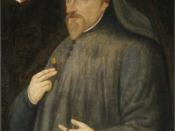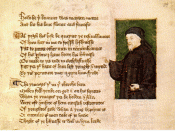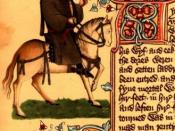Externally Different, Internally the Same
The Canterbury Tales is the most famous work of Geoffrey Chaucer, a late fourteenth century English poet. Chaucer envisioned English poetry which could be read by anyone who spoke English. The Canterbury Tales was his attempt at making that vision a reality. The story begins at the Tabard Inn in London, with a group of people planning a pilgrimage to Canterbury Cathedral. The travelers decide on a game in which each of them is to tell stories to the others to relieve the boredom of the journey. The pilgrims represent a cross-section of fourteenth century life, representing the feudal system, the ecclesiastical church order, and the urban working class. Two of the pilgrims, the knight and the plowman, represent the high and the low of the feudal class.
The knight's possessions and the plowman's possessions are basically similar, a surprising fact because of the difference in their rank.
The knight wore a very coarse cloth of cotton and linen, which had dirty smudges where his armor had left its mark. The plowman wore a short smock, which likely was also dirty because of his job. The knight also owned fine horses which shows that he was most likely under the rule of a rich lord, or that he himself was very wealthy. The plowman's much lower social status is denoted in his riding a mare. Strangely enough, neither of these characters seems to be carrying anything else. The knight is on the pilgrimage to "render thanks," so it is very likely that he simply did not find it necessary to bring along extra items. The plowman, though, probably did not have much else he could have brought. Even with the similarities of their possessions, there is clearly a difference between the status of the...


